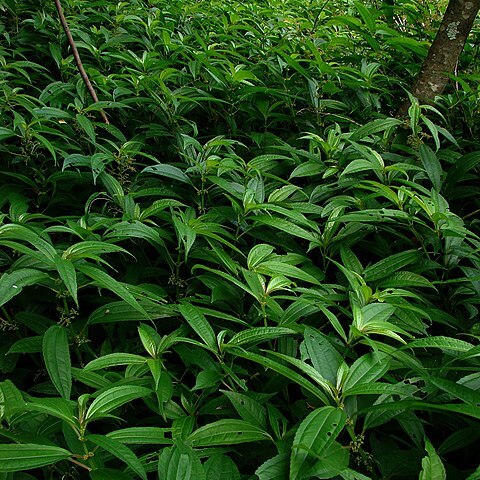Annual or perennial herbs, monoecious or rarely dioecious by abortion, sometimes with somewhat lignified basal parts or suffrutescent, mostly with juicy, translucent and turgescent stems, which may occasionally have scattered glandular cells in epidermis. Leaves opposite, petiolate, the two of a pair sometimes of unequal size; stipules intrapetiolar, fused completely to the apex, caducous or persistent; lamina entire, serrate or dentate, triplinerved; cystoliths linear, rarely punctiform. Inflorescences axillary or apparently terminal, unisexual or bisexual, pedunculate or sessile, bracted at least when young, in dichotomous cymes or in dense capitular clusters, either single or in branched paniculate inflorescences. Male inflorescences usually develop before or below the ♀. Male flowers usually 4-merous, rarely (2–)3-merous, often with tepals fused at base, mostly appendiculate (with a small, horn-like appendage at apex or subapical); rudimentary pistillode poorly developed or completely absent. Female flowers usually 3-merous, of which the tepals ± fused at base, the middle perianth-segment is usually the largest and ± appendiculate at apex, the lateral ones much smaller; a scale, representing a staminode, present inside each perianth-segment, hyaline, at first inflexed, reflexed at maturity and forcibly ejecting the achene; ovary erect, with apical sessile penicillate stigma. Achene compressed, ovate or elliptic; endosperm scarce. Embryo with large cotyledons.
Herbs, shrubs, or subshrubs , annual or perennial, glabrous. Stems simple or branched, erect, ascending, or repent. Leaves opposite; stipules present. Leaf blades paired, equal or unequal, ovate, margins dentate or entire; cystoliths linear, ± conspicuous. Inflorescences axillary, compact to lax cymes. Flowers unisexual, staminate and pistillate flowers in same cyme; bracts deltate to linear. Staminate flowers: tepals 4; stamens 4; pistillode conic. Pistillate flowers: tepals 3, equal or sometimes 1 tepal enlarged and hoodlike; staminodes 3, opposite tepals, under tension and ejecting mature achene; style and tufted stigma deciduous. Achenes sessile, laterally compressed, ovoid to teardrop-shaped, free from perianth at maturity, partly covered by hoodlike tepal. x = 12, 13.
Annual or perennial herbs or subshrubs, sometimes prostrate, dioecious or monoecious, without stinging hairs. Leaves opposite, pairs sometimes unequal, the lamina entire or incised, usually 3-veined, with linear cystoliths present; stipules joined in pairs or obscure. Inflorescence axillary, in lax or dense cymes, or sessile, sometimes clustered. Male flowers 4 (or 5)-merous; perianth segments often with a dorsal to apical appendage, stamens opposite perianth lobes, inflexed in bud; pistillode small. Female flowers with 2 or 3 perianth lobes, 1 longer than the others and sometimes hooded over ovary or fruit; ovary erect; stigma sessile, penicillate. Achenes ovoid, slightly compressed and oblique, often partially enclosed by perianth.
Annual or perennial, monoecious or dioecious herbs, sometimes suffrutescent, often succulent, without stinging hairs; stipules intra-axillary, deciduous or per-sistent; leaves opposite, usually petiolate, toothed or entire, those of a pair equal or markedly unequal, similar in shape or very dissimilar; flowers in unisexual or androgynous clusters, these solitary or forming cymes or panicles; staminate flowers 4 (rarely 2 or 3 )-parted, the pistillate normally 3-parted, the middle segment usually larger than the lateral ones; stigma sessile, penicillate; achenes compressed, orbicular or ovate.
Monoecious or dioecious; cal of the male fls deeply 4-parted; stamens 4; cal of the female fls deeply 3-parted, the segments often unequal or gibbous or hooded; staminodes minute, scale-like; stigma sessile; fr a compressed, thin-walled achene, loosely subtended by the persistent cal; herbs with opposite lvs, inconspicuous, connate stipules, and axillary cymes of small, greenish fls, the numerous cystoliths appearing as minute, whitish lines on the surface of the lf in herbarium-specimens blades with scattered, minute stinging hairs. 200, mainly trop.
Herbs, dioecious or monoecious. Leaves opposite, those of a pair often unequal in size and shape; stipules connate; blade with pinnate, sub-triplinerved or single-nerved venation. Inflorescences unisexual or bisexual, branched or unbranched; flowers pedicellate or sessile. Staminate flowers with (3 or) 4, connate tepals; stamens (3 or) 4. Pistillate flowers with 3, basally connate, unequal tepals, the middle one the largest; stigma capitate-penicillate, persistent or caducous. Achene subtended by the hardly enlarged tepals.
Female flowers with 3 tepals, one considerably larger than the other two, usually cuculate or with a dorsal horn-like appendage. Three scale-like staminodes present, inflexed, but ultimately reflexing and thus ejecting the achene. Ovary symmetrical, erect, with a sessile, penicillate stigma.
Male flowers (3)4(5)-merous, tepals corniculate with a dorsal horn-like appendage; stamens as many as the tepals; ovary rudimentary.
Leaves opposite, petiolate or subsessile, each of a pair unequal in size, triplinerved, usually with serrate margins.
Annual or perennial herbs, monoecious or dioecious by abortion.
Stems juicy, translucent and turgescent; stinging hairs absent.
Flowers in unisexual or bisexual cymes or panicles.
Stipules intrapetiolar, almost completely fused.
Achene ovoid, ± smooth, compressed.
Embryo with large cotyledons.
Cystoliths linear.

